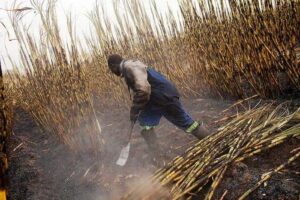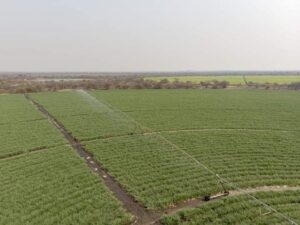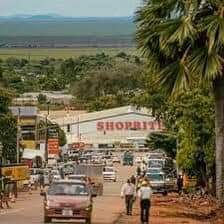
Sugar cane plantation
MAZABUKA: The Green Green Grass of Home
…..But not all that is green is grass.
Reminiscing, some childhood events are so deeply etched that when recalled, memories unravel from the obscurity of the fringes of the mind, so vivid that even the nostalgic fragrances of ages long gone come back alive!
——————————————————————
By Davis Mataka. Wednesday, 7th September, 2022
The year was 1972 and I was just a little over six years old. Like any kid my age, I was extremely impressionable, I grasped and questioned every little thing that came my way.
I was told we were leaving our home at No1 Keswick Drive Itawa in Ndola and we were going to live in another town called Mazabuka. Where the hell was Mazabuka? why were we leaving such a nice home? who were we going to live with? My prodding mind demanded answers as my eyes began to well with tears.
My father had just been posted from the Ndola Sugar Refinery to the Nakambala Sugar Estates. This single event changed my life, all our lives forever.
The journey from Ndola to Mazabuka by road was one I had not undertaken before. For a six year old, It was a long tideous, eventless and outright excruciatingly boring trip.
I however found solace in the deep steady roar of my father’s V6 Ford Zepher which cradled me to sleep countless times during the journey.
Gladly, each time I opened my eyes and peered through the window, the passing view outside was different. And for the umpteenth time I asked if we had arrived Mazabuka? The answer I got was again a no not yet. I was getting more anxious and irritated.
My siblings, Doris Mwanja who is the oldest and my younger sister Lillian Brenda Walya seemed resigned to their fate, as they endured the whole trip quietly and without protest. Maybe because they were girls, they took this ‘grave’ matter more calmly and submissively than I did. Our youngest brother Oliver Kasongo would only be born a year later.
Only if Oliver was born at the time, he and I would have staged a mutiny of sorts. We wouldn’t have gone down without a fight, kicking and screaming. Nobody would have taken us alive to this god forsaken, nobody cared for, remote green valley where black rain fell whenever a cane field was set alight. Oh well, so it seemed at first sight.
And so as we hurtled south into this unknown world. My narrow childish mind wondering at the endless green woodland we were encountering.
The narrow tarred road from Turnpike near Kafue to our destination was almost a one track way and so often, our vehicle had to veer off road to give way to on coming traffic.
What Bush were we going to, was this the Mazabuka my parents bargained for? Would I find the similar niceties our home in Ndola offered waiting for me?
The warm bed, the nice food and most especially, the sweets chocolate and biscuits? This place was a forest, There is no way It could match my old house in Ndola, no way, I quipped.
The last thing I remembered being on the road that evening was stopping to give way to a big herd of cows crossing the road. My two sisters and I had never seen such a spectacle. We marvelled at the scene. Lillian who seemed most enchanted yelled in excitement “ah! imbwa kukula”Meaning, oh those dogs crossing the road are so big.
Breaking out in laughter my parents corrected her saying they were actually Ngombe, cows not big dogs.
I must have fallen into deep sleep with the ‘big dogs’ on my mind, because my dreams were filled with encounters with Zambolina, the television milk cow character as advertised by the Dairy Produce Board.
I woke up well rested to a new day, to a new life, but boy was I famished. I smelt good food. There was a strong aroma of bacon, fries and eggs in the air. All that mattered to me now was food.
And If this was the kind of stuff we were going to start on, then Mazabuka was not completely a bad idea. Life would be good.
Well, we had finally arrived in Mazabuka and were lodged at the Nakambala Guest House.
(To be continued……)
………MAZABUKA THE GREEN GREEN GRASS ……..continued.
By Davis Mataka Saturday, 5th November, 2022
The allure of the still, dark and starry night sky suddenly metamorphoses. A steady glow of deep orange and flashes of crimson slowly illuminate the horizon as huge tounges of flame leap dozens of feet high into the air.
Like a second sunset, the golden rays of this towering inferno pierce through the clouds of the plumes of smoke forming above.
And from miles around, it begins to rain. Small soft black particles float effortlessly falling down to earth. And in no time, every inch of the ground is blanketed by the black rain.
This phenomenon plays out courtesy of a pre- harvest ritual performed when hectare upon hectare of green mature white tussled cane is set alight in a controlled blaze. A liturgy to rid the cane fields of excess foliage and unwanted serpants and rodents.
The now half baked brown sugar cane stalks stand exposed ready for the ‘Manyengo’ to do what they know best. It only happens in Mazabuka.
—————————————————————————
BY DAVIS MATAKA
If you are a first time visitor or passerby in this snoozy looking town of Mazabuka, you are fooled by the mundane looking main streets and the single column of shops that line the sloppy hillside they call the town centre.
However, tucked away and hidden from view is a large cosmopolitan metropolis whose economy evolves chiefly around the sugar industry.
Historically, Mazabuka draws it’s status as an industrial farming hub. A sizable blend of big white settler community commercial farmers and locals who grow huge amounts of maize; are into cattle ranching and are involved in an elaborate sugar cane outgrowers scheme.
They all feed into the Nakambala sugar mill, the biggest on the whole continent.
Iam proud to be part of the heritage of this sweet success story, born of parents who spent most of their working life with Zambia Sugar. I grew up, lived in, was schooled, and once worked for this enterprise .
My early childhood inhibitions of living in this good old town dissipated like a mist with the realisation that it was in fact a whole world rolled into one.
What with the plethora of cultures and influences from, all over the world.
The town once boasted of a fusion of Mauritians, Jamicans, South Africans, the British, Indians, Sri lankans, Americans and of course our own ‘Zambian whites.’ (I say that without prejudice)
Yes, Zambians of caucasian persuasion because most of them were born and bred here. I challenge anyone to a showdown in the spoken tonga language because In your attempt to impress, you are sure to twist your tongue. They are flawlessly fluent.
Most predominant are the native Tongas, the Lozi, Manyengo and a forever growing number of Bemba and eastern dialect speaking families. A mixed grill of cultures .
In hindsight, had I remained living in Ndola, I just may have been consumed by the Kopala swag.

View of a sugar cane plantation in Mazabuka District of the Southern Province, Zambia
Not a bad place to grow up, but knowing myself, the ability to stay out of mischief could have been a little bit too overwhelming. Oh well, because I hear when younger, I had a high affinity with trouble. But that of course, a matter of conjecture.
Maybe, I would have ended up toiling in one of the mines as a cheeky Kashimugodi doubling as a firebrand trade unionist.
Or an out-law, one of those cantankerous characters from the Copperbelt, hustling, scraping a living on the street.
Better still, I could have turned out to be, a politician. Possibly a fiery member of parliament, or a chief executive in one of the up-town manufacturing firms.
So really, Mazabuka was fine for me, and gladly, as it turned out later, it was a place to die for.
I ultimately became a scribe and I have never looked back. I do not know the instigation, maybe my proddiing mind? But if you ask me the inspiration, I know my late mother played a huge part of it.
Nakambala was built around the same model as the mining towns on the Copperbelt. A gated, self contained secluded community where everyone knew everyone
The very epitome of Industrial farming business expertise. This in a few words is the best way to describe the venture at Nakambala.
A technologically sophisticated medley of tasks, that like magic turns cane into crystal. The teams at Nakambala work like ants. From the sprawling cane fields, to the mill spewing the sweet white stuff. Every single one of them with a unique function ultimately contributes to what today is Mazabuka.
What immediately knocks you off your feet when you enter the unimposing gates into the sugar estate is the swathes of green cane fields that roll on and on as far as the eye can see, and the distinct caramellic smell that hits you. One you cannot immediately put a finger to.
A polite security person scrutinises you and almost apologetically asks what your order of business is. With a few pleasentaries, the gates are flung open for you to enter the sweetest spot in the nation. Sweet in the strictiest sense of the word.
One of the screaming traffic signs that greet you is when you arrive is a caution which reads ‘Cane Traffic Always Has Right of Way’. Those tractors never stop or give way at any intersection.
Nakambala has a huge number of cane haulage heavy duty tractors which at every minute criss- cross the maze of roads which speed along with abnormally long and heavy trailers laden with freshly cut cane, off to the factory.
Like any time bound business, everyone in this place has deadlines to keep. By estimation, the slowest I have ever seen those tractor drivers cruise is 60 Kilometres per hour.
The state of the road network is also one that never disappoints because those ‘freeways’ are smooth and sweet as they could ever be.
Eat your heart out Cairo road!, At Nakambala, all roads, like icing on cake are lined with molasses. That explains the sweet smell of caramel forever lingering in the air. The local name of molasses, a by product of sugar is ‘Mubyompyo.’ Quite an ear catching, fascinating name.
When mixed with water and sprayed on the gravel roads, molasses dries up quickly forming a hard cast which keeps away dust and any loose stones. It hardens like concrete and evens the road. Another unique and quality innovation only seen in Mazabuka.
There is however a down turn to this novelty because even as it forms a perfect rock solid sheet over the roads during the dryer months, a constant heavy down pour slowly melts it off forming a dark brown sticky substance.
Wet Mubyompo is one of the worst nightmares for drivers and pedestrians roaming the roads there and Nakambala will never warn about it.
Walking home Pupils, suffer the full brunt of Mubyompyo, losing the soles of shoes in the sticky puddles, or bored with the same pair, it is the best way to get parents to buy you a brand new pair.
Ladies, for those who love Platforms, heels, sandals, or flip-flops, take heed. Your life’s most embarrassing moment is nigh if you dare strut on Mubyompyo!
I had witnessed such moments once too often when, unsuspecting well dressed girls ended up walking barefooted with a handbag in one hand and a torn shoe in the other. Another victim of sweet Mubyompyo. Makes for a good season for the cobblers.
For motorists, a quick wash ought to keep away the sweetness. The problem however arises when you keep it on the body of a vehicle too long. It begins to slowly eat on the car. It is like your teeth and sweets. A thorough brush twice a day will keep tooth decay at bay.
The staff housing area was another neatly arranged residential site. We used to affectionately call it ‘kuma mauritian’ because of the large number of Mauritian families that resided there in the mid seventies.
Good old family names like the Augusties, Rajaballys, Lenos, Kibeya (SP), and many others.
Most of them returned to Mauritius after their contracts ended.
The more high density housing areas are the famous Njomona, Nkabika, Kamwala, Kaleya, Nakambala Stage II, Bean Farm, Rushmore Farm and so many others.
This formed part of the compliment of what is Nakambala.
One of the first houses we lived in was on the sugar estates. NoS1 Chirundu way.This was the first of a cluster of about 20 or so houses which was allocated to senior staff together with the General Manager’s residence now Managing Director.
It was a fine large and spacious three bedroomed white house with sprawling gardens dotted with gigantic indeginous trees. Neat and well tended lawns, flawlessly groomed rose bushes, petunias, large elephant ear plants, dandelion with rows of banana plants spanning the extent of the yard. The wire fencing was expertly knitted together with a grass thatch to keep away all the unwelcome glares.
What coined the overall decor of the gardens was a well spruced vineyard of blossoming succulent delicious mouth watering dark purple grapes which flourished abundantly. It also doubling as a canopy of creepers above and around a paved walk way half way around to the front of the house.
This opened out into a large open air veranda area and nestled in the middle, was a rectangular shaped fish pond with large gold fish twirling and splashing, playing hide and seek in between the waterlillies and the reeds. It came complete with a flowing fountain throwing a steady spray of water into the air. Extremely beautiful and picturesque.
I must concede, this was the real mayadi. Ok, the Ndola arrangement was decent but mmmh!
Fine, Itawa was in the early seventies an exclusive neighbourhood, and if living with alot of white folks was a high bar of attainment in social status for a young African family such as mine, then we were living it. But really, that was nothing and nowhere close compared to Nakambala.
The inside of the house was yet another splendid work of ingenuity. Everything was up to class.
The fire place in the living room, as it turned out to be was the convergence centre of all family activity. A place to finally unwind after all the chores and chaos of the day.
Like numerous other living rooms I have been to, most of the sitting furniture faced the fire place.
Unlike some fake fire places, ours was special in that it was not just placed there for purposes of decor and placement of ornaments on the mantle. This one was live, and usable with a working chimney.
In the colder days of the year, my father collected firewood and lit up a fire, warming up the whole house as we gathered around him listening toq folk tales and songs from the village.
But this one day was not to be like the others before. After the send off to bed following yet another exciting evening of folklore, we retired.
‘Nganda yapya!’ The house is on fire! was the repeated shrill that jolted me out of bed. Not fully comprehending, my eyes still half closed with a gruffy voice I questioned where and how as I staggered to follow the sound from where the screems where coming from.
Half way in the long corridor, I met my father in his night gown in a half sprint rushing towards the living room.
My older cousin Violet who attended Mazabuka Girls Secondary was usually the earliest in the home to prepare for school.
She was the first to encounter the choking black smoke as she flung open the door that seperated the living room from the private sleeping area. It was her that sounded the alarm disturbing the last sweet moments of my sleep.
With a whole panicked household wide awake and in a wild frenzy, my father struggled to open the doors and shunted us out literally throwing us out one by one.
Apparently, one of the logs which did not completely burn out kindred , lost its balance as it slowly burnt out tipping over and rolling onto the carpet which in turn slowly burnt and in turn consumed a larger three seater couch.
The last adult to go to bed usually made sure that the smouldering logs were smothered wet with water making sure that every umber was extinguished and pushed deeper into the fire area.
Up to now, we have never figured out who the last person to go to bed was.
That was the last time we ever enjoyed a warm night courtesy of the fire place and I lived to tell the tale……to be continued.

Sugar manufacturing plant https://www.facebook.com/100019500055234/posts/pfbid0y1PYe6TREKVU4AovqPgWjoLHpmumTh9QmBa1PxJ2RnScSZ9ubatnoajtGbRmK9Xkl/




